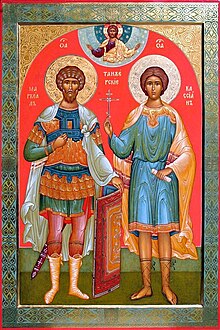Cassian of Tangier

Cassian of Tangier († December 3, 298 in Tangier ), also called Cassian of Tingis or Cassius , was a Christian martyr . The Roman Catholic Church venerates him as a saint , and the Protestant Church in Germany also considers him a memorable witness of faith.
General
According to tradition, he was beheaded on December 3, 298, during the reign of Diocletian . The martyrdom of Cassian is traditionally seen as a consequence of the martyrdom of Marcellus of Tangier . He is said to have been a clerk in the proceedings against Marcellus. Aurelius Agricola, deputy prefect of the Roman province in North Africa , is said to have directed the proceedings. When the death penalty was imposed on Marcellus, Cassian allegedly threw down his pen and professed Christianity. He is said to have been arrested immediately and put to death. Cassian is considered to be the patron of modern stenographers . However, the connection with the martyrdom of Marcellus is now considered by some experts to be undetectable. Cassian of Tangier is mentioned by Prudentius (* 348) in his hymn Liber Peristephanon ( De Coronis Martyrum ) (Carmen IV, 45-48):
"Ingeret Tingis sua Cassianum,
festa Massylum monumenta regum,
qui cinis gentes domitas coegit
ad iuga Christi."
Possible translation:
“Tingis leads what is his: Cassianus,
whom Massylian rulers once honored;
whose ashes the heathen peoples
Christ won. "
Memorial days
- Protestant: October 28 in the Protestant name calendar (together with Marcellus von Tanger)
- Roman Catholic: December 3 (the traditional day of his death)
See also
- Kassian of Imola
Individual evidence
- ↑ Geoffrey Ernest Maurice de Sainte Croix , Christian Persecution, Martyrdom, and Orthodoxy , Oxford University Press, 2006, p. 172 (translated here): "we must admit that we know nothing about the date or circumstances of his execution"
- ↑ HYMNUS IN HONOREM SANCTORUM DECEM ET OCTO MARTYRUM CAESARAUGUSTANORUM The Latin Library, accessed July 12, 2018.
- ^ Pius Bonifatius Gams , The Church History of Spain , published by Georg Joseph Manz, 1862, Volume 1, p. 321
source
The article was originally translated from the English Wikipedia, the source of which is:
- Vincent J. O'Malley, Saints of Africa , Ed. Our Sunday Visitor Publishing, 2001, p. 164.
| personal data | |
|---|---|
| SURNAME | Cassian of Tangier |
| ALTERNATIVE NAMES | Cassian of Tingis; Cassius |
| BRIEF DESCRIPTION | Christian martyr in Tangier |
| DATE OF BIRTH | 3rd century |
| DATE OF DEATH | uncertain: December 3, 298 |
| Place of death | Tangier |